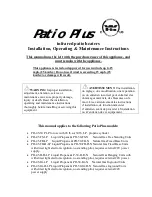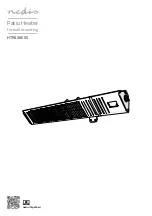
Operation (Continued)
VENTILATION
Risk of indoor air pollution. Use heater
only in well ventilated areas.
Provide a fresh air opening of at least 3 square feet. (2,800 sq.
cm.) for each 100,000 BTU/Hr. rating. Provide extra fresh air if
more heaters are being used.
TO START HEATER
1. Fill fuel tank with kerosene or No. 1 fuel oil.
2. Attach fuel cap.
3. Plug power cord into three-prong, grounded extension cord.
Extension cord must be at least six feet long.
Extension Cord Wire Size Requirements:
•
6 to 10 feet long, use 14 AWG conductor.
•
101 to 200 feet long, use 12 AWG conductor.
•
201 to 300 feet long, use 10 AWG conductor.
•
301 to 400 feet long, use 8 AWG conductor.
•
401 to 500 feet long, use 6 AWG conductor.
4. Push “OPERATION BUTTON”. Power indicator lamp and room
temperature display will light and heater will start. Push the up
and down arrow keys on the control panel to adjust the
thermostat settings.
If heater does not start, the thermo stat setting may be too low.
Push “TEMP CONTROL UP ARROW” to higher setting to start
heater. If heater still does not start, see Troubleshooting Chart on
page 14-15.
NOTE:
The major electrical components of this heater are protect-
ed by a circuit breaker (fuse) mounted to the power switch. If your
heater fails to start, check this first and replace as necessary. You
should also check your power source to insure that proper voltage
and frequency are being supplied to the heater.
NOTE:
When using diesel fuel in cold ambient temperatures
(below 35° F) fuel additives will be required to prevent the diesel
fuel from “jelling”. Follow the mixing instructions provided by the
diesel additive supplier for the correct additive/fuel ratio.
TO STOP HEATER
Never unplug heater while heater is
running.
Heater must go through cooling cycle. The cooling cycle cools the
combustion chamber.
Damage to heater can occur if combustion chamber is not cooled.
Do not restart heater until cooling cycle is complete.
1. Push “OPERATION BUTTON”, This will cause heater flame to
go out. The motor will continue to run during the cooling cycle.
This allows the fan to cool the combustion chamber. When the
cooling cycle (approx. 2 minutes) is finished, the motor will stop.
Do not unplug heater until cooling cycle is finished
.
2. Disconnect heater from power source.
3. To temporarily stop heater, set thermostat at a temperature
lower than air around heater. Heater will cycle back on if air
temperature around heater matches thermostat setting.
TO RESTART HEATER
DO NOT restart heater until
cooling cycle is finished.
The cooling cycle cools the combustion chamber.
1. Wait until cooling cycle is finished after stopping heater.
2. Repeat steps under TO START HEATER.
ELECTRICAL OUTLET
Shock Hazard!
- Never plug in an appliance with more than 5amp rating in this
outlet.
- Always keep outlet covered when not in use.
- 120V 5amp max (non fused).
LONG-TERM STORAGE OF HEATER
1. Remove drain nut from rear bottom side of fuel tank by
unscrewing nut and drain. See Figure 6.
2. Using a small amount of kerosene, swirl and rinse the inside of
the tank.
NEVER MIX WATER WITH KEROSENE, as it will cause rust
inside the tank. Pour the kerosene out, making sure that you
remove it all.
Page 7
NEVER FILL THE FUEL TANK INDOORS.
ALWAYS FILL THE TANK OUTDOORS.
BE SURE THAT THE HEATER IS ON LEVEL GROUND WHEN
FUELING, AND NEVER OVERFILL THE FUEL TANK.
CAUTION
NEVER LEAVE HEATER
UNATTENDED WHILE BURN-
ING OR WHILE CONNECTED
TO A POWER SOURCE
Kerosene
Forced Air Heaters
Figure 5 – Control Parts
Operation
Button
Temp Control Buttons
WARNING
©2014 Pinnacle Products International, Inc. Kerosene Heater User’s Manual


































